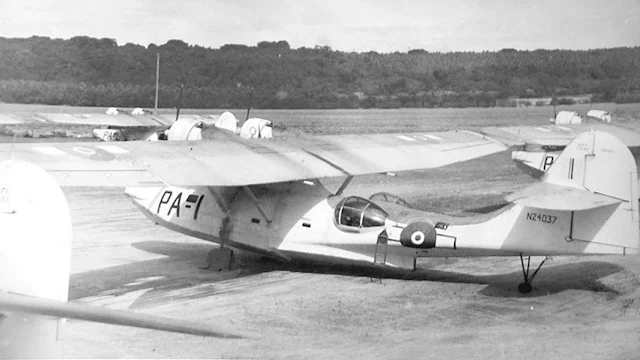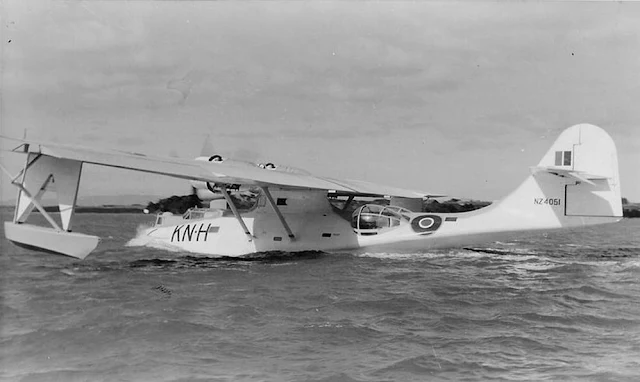 |
| Captured Focke-Wulf Fw 190 Würger being flight tested in the United States, probably out of Wright Field near Dayton, Ohio, 1944. during World War II. |
 |
| Fokker G.1. |
 |
| Fokker C.V. |
 |
| Fiat CR.32, Hungarian Air Force. |
 |
| Ground crews of 605 Squadron, Palembang, 1942. Uniformity has been sacrificed to comfort and protection during the retreat from Singapore. |
 |
| Bombs explode on the northern dispersal area at Abbeville/Drucat airfield, France, during an attack by 18 Lockheed Venturas of No. 21 Squadron RAF and No. 464 Squadron RAAF. |
 |
| Messerschmitt Bf 110. |
 |
| Kesselring inspects members of a Luftwaffe Me 110 unit. |
 |
| Bristol Beaufighter with torpedo. |
 |
| Bristol Beaufighter at Magun, Libya, 1943. Royal Air Force ground crew overhauling a Bristol Beaufighter's Hercules engines at Magrun. |
 |
| A spreading patch of burning oil and petrol on the surface of the water, following the shooting down of a Junkers Ju 88 by Bristol Beaufighters of No. 248 Squadron RAF over the Bay of Biscay. |
 |
| Fairey Battle K4303. |
 |
| Contrails above London after dogfight between British and German aircraft. September 1940. |
 |
| British barrage balloon being deployed. |
 |
| German barrage balloon being deployed. |
 |
| French anti-aircraft fire during a Nazi raid on Algiers, 1943. |
 |
| A Douglas Boston bomber of the Royal Air Force heads for home after dropping its payload on the Axis defenses of Pantelleria astride the invasion route for Sicily. |
 |
| Lt. Gen. Hugh Drum is seen meeting with other senior military personnel at Grenier Field, New Hampshire. A Douglas A-20 Havoc light bomber is visible in the background. |
 |
| A4b rocket. First launched January 24, 1945 as a modification of the V-2 (A-4) rocket. |
 |
| PZL P-11c fighter from the 141 Fighter Squadron, Polish Air Force, assigned to the "Pomorze" Army, abandoned at the airport in Toruń in a damaged condition (without engine reducer). 1939. |
 |
| Visit of Polish airmen in the United States, September 1932. Col. Jerzy Kossowski in front of PZL P.11. |
 |
| PZL P.11c, Polish Air Force. From the 3rd Air Regiment in Poznań - Ławica. |
 |
| Polish Air Force PZL P.11 interned after it landed in Hungary. It carried civilian markings at first and was later studied at the University of Technic. |
 |
| The cockpit of the Hungarian-interned Polish PZL P.11. |
 |
| Destroyed light bomber PZL P-46 "Sum" prototype. |
 |
| Destroyed PWS 33 Wyżeł and three PZL.37 Łoś medium bombers, Okecie airport. |
 |
| One of the destroyed PZL.37 Łoś medium bombers at the Okecie airport. |
 |
| Captured PZL.37 Łoś medium bombers under construction. |
 |
| The same two captured PZL.37 Łoś medium bombers under construction. |
 |
| Former 19th Bomb Group B-17D that was pieced together from several damaged aircraft abandoned by the US in the Philippines. |
 |
| B-17E taken as a prize in Java. The photo was taken from the B-17D in the previous picture. |
 |
| Brewster B-339 serial number B-3119 of the Royal Netherlands East Indies Air Force. |
 |
| Prince Bernhard’s Beechcraft D17S Staggerwing PB1 in RAF camouflage and markings but note the Dutch insignia on the nose, an orange triangle with a black border. |
 |
| Prince Bernhard’s Beechcraft D17S Staggerwing with registration PB1, 1942-45. |
 |
| Dutch crew gets on board one of the Fokker T.VIIIW seaplanes that escaped from the Netherlands to England, 1940. |
 |
| Dutch Naval Aviation Service in England. Launching of one of the Fokker T.VIIIW seaplanes that escaped from the Netherlands to England, 1940. |
 |
| Fokker T.VIIIw (AV961), No. 320 (Netherlands) Squadron RAF, Pembroke Dock, Wales, August 1940. |
 |
| Fokker G.1, Dutch air force. |
 |
| Brewster Model 339D Buffalo of the ML-KNIL. |
 |
| Javanese ground staff preparing ammunition to load guns on a Netherlands East Indies fighter aircraft, January 1942. |
 |
| At a Netherlands fighter squadron, a Javanese member of the ground staff closes one of the gun-bay panels on a Dutch Brewster Buffalo fighter, January 1942. |
 |
| Fokker C.XI-w. |
 |
| Fokker D.XVII. |
 |
| Fokker D.XXI (213 c/n 5486) Netherlands Army Air Service. Schiphol Airport, Amsterdam, the Netherlands, 1938. |
 |
| Fokker D.XXI prototype. |
 |
| Fokker G.1a cockpit. |
 |
| Fokker T.V (850). |
 |
| Fokker D.XXI (213, 215) and Fokker T.V (852). |
 |
| Another view of Fokker T.VIII in pre-war Dutch markings. |
 |
| RNZAF F4U-1D Corsairs of 31 SU (Servicing Unit) at Palikulo Bay Airfield (Bomber #1), Espiritu Santo, 31 Oct 1944. |
 |
| RNZAF Douglas Dauntless at Espiritu Santo. |
 |
| Catalina NZ4017 6 (Flying Boat) Squadron RNZAF at Halavo Bay, Florida Island, December 12, 1944. Note the Insignia Blue borders to the under wing roundels. |
 |
| Boeing PB2B-1 Catalina NZ4038 5 (FB) Squadron RNZAF being launched at Segond Channel. The detachable beaching gear is being dragged ashore. |
 |
| Boeing-built PB2B-1's of 5 (FB) Squadron at Segond Channel, 1944. |
 |
| NZ4013, the first PBY-5 Catalina to arrive in New Zealand, at Hobsonville in July 1943. Note the modified roundels with the reduced Red centers. |
 |
| Another photo of NZ4013 moored off Hobsonville after its arrival. Note how the ortho film has darkened the red and yellow of the roundel, and lightened the blue. |
 |
| Boeing-built PB2B-1 Catalina NZ4028 of 3 (FB) Operational Training Unit RNZAF at Lauthala Bay, Fiji. |
 |
| Catalina NZ4016 6 (FB) Squadron RNZAF flying from Segond Channel, October 1943. The heat exchange manifolds are still in place. |
 |
| The perils of a night landing. Catalina NZ4003 6 (FB) Squadron RNZAF after water looping, and crashing into a Liberty ship, Segond Channel, October 31, 1943. |
 |
| Catalina NZ4018 XX-U 6 (FB) Squadron RNZAF at Segond Channel, New Hebrides, late 1943. White bars without borders have been added to the fuselage roundels. |
 |
| Catalina NZ4022 RNZAF at Lauthala Bay, Fiji, October 1943. Note the graduated blending of the upper color to the undersides. |
 |
| Catalina NZ4038 PA-J 5 (FB) Squadron RNZAF Segond Channel. |
 |
| Catalina NZ4033 PA-E 5 (FB) Squadron RNZAF Segond Channel. |
 |
| Catalina NZ4033 PA-E 5 (FB) Squadron RNZAF Segond Channel. |
 |
| Catalina NZ4037 PA-I 5 (FB) Squadron RNZAF Segond Channel. |
 |
| Boeing-built PB2B-1 Catalina NZ4051 KN-H RNZAF. |





















